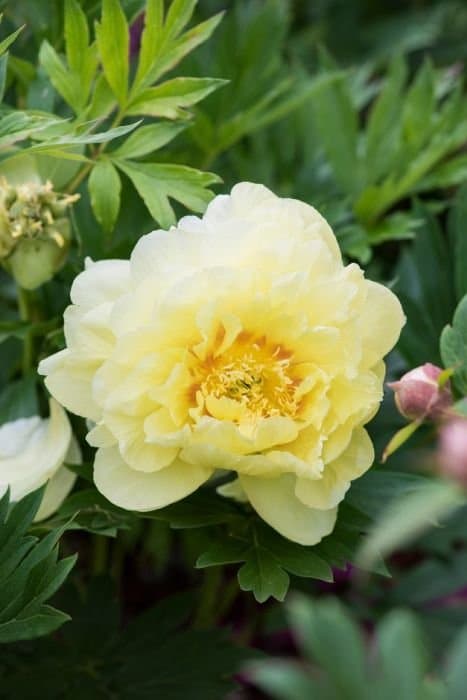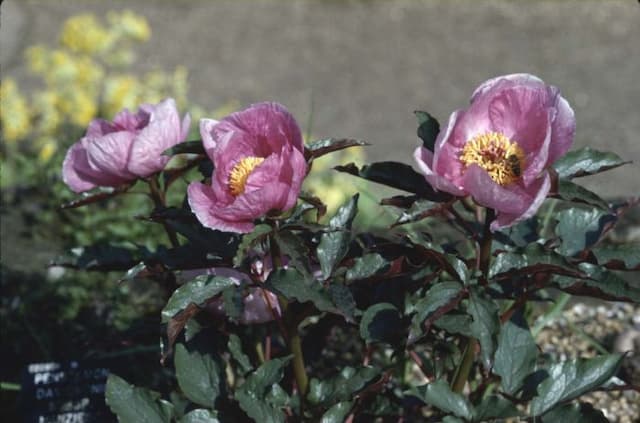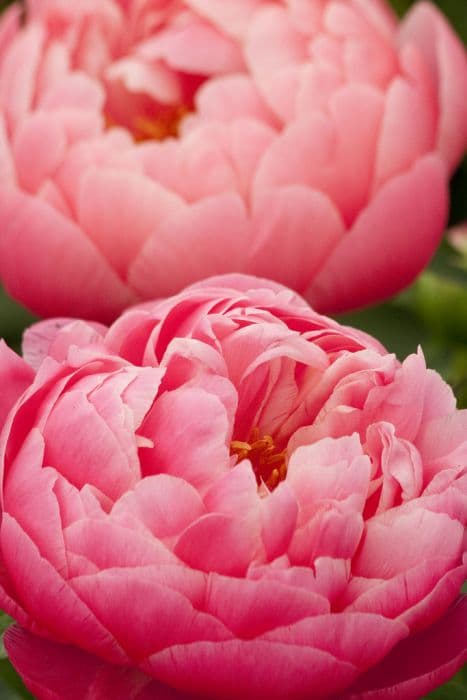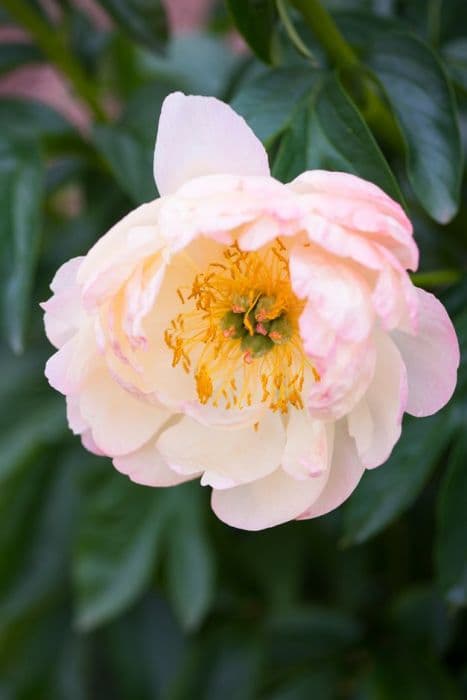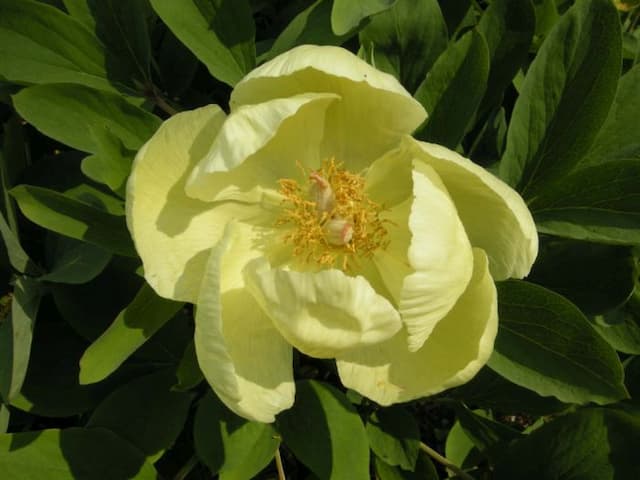Peony Paeonia 'May Apple'

ABOUT
The 'May Apple' peony is a beautifully ornamental plant known for its lush foliage and attractive flowers. The leaves are large and deeply lobed, presenting a rich green color that adds to the plant's visual interest even when it is not in bloom. These leaves create an elegant backdrop for the flowers, which are the main spectacle of the 'May Apple'. The blooms are typically large, with multiple layers of petals that range in color from pale pink to deeper shades, depending on the variety. Each flower has a voluminous, ruffled appearance, adding to the overall opulence of the plant. The peonies exude a pleasant fragrance that can make them a delightful addition to any garden space where their beauty and scent can be enjoyed.
About this plant
 Names
NamesFamily
Paeoniaceae.
Synonyms
May Apple Peony.
Common names
Paeonia suffruticosa, Paeonia suffruticosa 'May Apple'.
 Toxicity
ToxicityTo humans
The Paeonia, commonly known as peony, is not considered highly toxic to humans. However, some people may experience an adverse reaction to it, particularly if they consume parts of the plant. Symptoms from eating parts of the peony plant may include gastrointestinal upset, such as nausea, vomiting, and diarrhea. In most cases, peonies are not life-threatening to humans, but consuming large quantities or for individuals with specific sensitivities it may lead to more severe reactions.
To pets
The common peony is known to contain compounds that can be toxic to pets if ingested. Symptoms of peony poisoning in pets might include vomiting, diarrhea, and less commonly, depression or anorexia. As with humans, ingestion of parts of the peony plant usually doesn't result in severe or life-threatening symptoms for pets, but it is still recommended to prevent pets from consuming peonies to avoid the risk of gastrointestinal upset or other potential reactions.
 Characteristics
CharacteristicsLife cycle
Perennials
Foliage type
Deciduous
Color of leaves
Green
Flower color
Varies
Height
2-3 feet (0.6-0.9 meters)
Spread
2-3 feet (0.6-0.9 meters)
Plant type
Herb
Hardiness zones
4-8
Native area
Asia
Benefits
 General Benefits
General Benefits- Ornamental Value: Peony 'May Apple' has attractive blossoms that enhance garden aesthetics.
- Attracts Pollinators: The flowers attract bees, butterflies, and other beneficial insects, supporting local ecosystems.
- Low Maintenance: Once established, peonies generally require minimal care, making them suitable for various gardeners.
- Longevity: Peonies can live for many years, even decades, providing long-term value for the garden.
- Seasonal Interest: With their spring blooming season, peonies add color and interest to gardens after winter.
 Medical Properties
Medical PropertiesThis plant is not used for medical purposes.
 Air-purifying Qualities
Air-purifying QualitiesThis plant is not specifically known for air purifying qualities.
 Other Uses
Other Uses- Paeonia 'May Apple' can be used as a natural dye, where the roots can provide a dark red or maroon color suitable for fabrics or artisan crafts.
- The plant may also serve as a flowering ground cover in landscaping, offering an aesthetically pleasing and low-maintenance alternative to grass.
- Paeonia 'May Apple' contributes to biodiversity by providing nectar and pollen for various pollinators such as bees and butterflies.
- The dried seed pods of Paeonia 'May Apple' can be used in floral arrangements to add a unique texture and visual interest.
- The leaves of Paeonia 'May Apple' can be used in creative crafting projects, such as natural leaf printing techniques on paper or textiles.
- Paeonia 'May Apple', when planted densely, can function as a weed suppressant due to its thick foliage overshadowing the soil.
- As a perimeter planting, Paeonia 'May Apple' can act as a natural border or fence line, defining edges in gardens and walkways.
- The plant can be included in wildlife gardens, offering shelter for small animals and insects.
- Paeonia 'May Apple' can be used in companion planting, possibly deterring certain pests due to its specific scent or chemical compounds released by the roots.
- The large umbrella-like leaves may be artistically inspiring and used as motifs or patterns in various forms of art, including textile design or botanical illustration.
Interesting Facts
 Feng Shui
Feng ShuiThe Peony is not used in Feng Shui practice.
 Zodiac Sign Compitability
Zodiac Sign CompitabilityThe Peony is not used in astrology practice.
 Plant Symbolism
Plant Symbolism- Healing: Peonies, including the May Apple, are often associated with healing due to their traditional use in medicine, symbolizing the body's ability to recover and restore health.
- Prosperity: In many cultures, peonies are symbols of wealth and success, and having them in the home is believed to invite financial abundance.
- Romance: Known for their lush, full blooms, peonies are frequently seen as emblems of love and romantic relationships, often used in wedding bouquets and arrangements.
- Beauty: The striking appearance of the May Apple peony, with its exquisite petals, represents the ideal of physical beauty and grace in various societies.
- Protection: Some traditions hold that peonies offer protection from negative forces, providing a sense of safety and security to those who keep them nearby.
- Good Fortune: The May Apple, like other peonies, is believed to bring good luck, particularly in the case of a new beginning or venture.
 Water
WaterPeonies, including 'May Apple', should be watered deeply once a week, providing about 1 inch of water which equals approximately 0.6 gallons per square yard. During the growing season, especially if the weather is dry, they may need additional water. It is important to avoid overhead watering to prevent fungal diseases; instead, use a drip system or soaker hose at the base of the plant. During the fall and winter, you can reduce watering as the plant goes dormant. Always check the soil moisture level before watering to ensure it is not too wet, as peonies do not like overwatering.
 Light
LightPeonies like 'May Apple' thrive in full sun to partial shade. They need a minimum of 6 hours of direct sunlight a day to bloom well. The best spot for peonies is an area that receives morning sun and some afternoon shade, especially in hotter climates to prevent the blooms from fading too quickly.
 Temperature
TemperaturePeonies, including 'May Apple', prefer temperate climates with winter temperatures that dip below 40 degrees Fahrenheit to ensure proper dormancy and spring blooms. Ideally, they grow best in temperatures ranging from 65 to 75 degrees Fahrenheit. They can survive winter chills down to about -20 degrees Fahrenheit and summer highs up to 90 degrees Fahrenheit.
 Pruning
PruningPeonies such as 'May Apple' need pruning to remove spent blooms and to shape the plant, which should be done immediately after flowering. Cut back the foliage to the ground in the fall to prevent overwintering diseases. It is also a good practice to remove any weak or damaged stems in early spring to promote healthy growth and air circulation.
 Cleaning
CleaningAs needed
 Soil
SoilPeonies prefer well-draining soil rich in organic matter with a neutral to slightly alkaline pH between 6.5 and 7.5. A mix of loamy garden soil, compost, and a bit of sand or perlite to improve drainage makes for the best soil condition for peonies.
 Repotting
RepottingPeonies, including May Apple, rarely need repotting and do best when left undisturbed. They may only need repotting or dividing every 10 to 15 years if they become overcrowded or less vigorous.
 Humidity & Misting
Humidity & MistingPeonies like May Apple are tolerant of a wide range of humidity levels and do well in the varying outdoor conditions where the average humidity aligns with typical garden environments.
 Suitable locations
Suitable locationsIndoor
Not ideal for indoor growth due to size and light needs.
Outdoor
Plant in sun to part shade in fertile, moist soil.
Hardiness zone
3-8 USDA
 Life cycle
Life cycleThe life cycle of the plant commonly known as Peony 'May Apple' begins with seed germination, which occurs when the seeds are exposed to a period of cold stratification, mimicking winter conditions, followed by warmth, resembling spring. After germination, the plant enters a vegetative growth stage, where it develops roots, stems, and leaves through the absorption of nutrients and water from the soil. The Peony 'May Apple' then reaches maturity and enters the flowering stage, producing large, often fragrant flowers that are typically pink, red, or white in color, attracting pollinators for reproduction. Once pollinated, the flowers form seed pods that mature and eventually release seeds, completing the sexual reproduction cycle. Some Peony 'May Apple' plants may also propagate asexually through the division of their tuberous root system, expanding clonally. The plant then goes dormant during the cold winter months, shedding its leaves and conserving energy in its roots until the next growth cycle begins in the spring.
 Propogation
PropogationPropogation time
Early spring
Peonies, including the 'May Apple' peony, are most commonly propagated by division, which is typically done in the fall after the plants have gone dormant. To propagate by division, a mature peony clump is carefully dug up and the root ball is cleaned of excess soil. Using a sharp knife or garden spade, the root ball is then divided into smaller sections, ensuring that each section has at least 3-5 eyes, which are the growth nodes where new shoots emerge. These sections are then replanted about 2 feet (approximately 61 centimeters) apart and at a depth where the eyes are 1-2 inches (about 2.5 to 5 centimeters) below the ground surface. Water well after planting and wait for spring to see the results of your propagation efforts.
